
Personality Style Aspects
The Physical, Emotional and Intellectual Energies within Personality Styles & Behavior Traits
Personality Traits develop into different Personality Styles, or, Personality Types as our body, heart and mind work together. The ratios and emphasis that we put on Physical, Emotional and Intellectual energies form the behavior traits that give us our different Interpersonal Styles. This alters our methods of behavior, our interaction with others, and our life decisions. The elements behind; Driver, Expressive, Analytical, Facilitator, Organizer and Amiable Personality Styles are; Physical, Emotional, Intellectual, Physo-Emotional, Physo-Intellectual, and Emo-Intellectual, respectively.
Physical styles of behavior are active driving force, assertive or even forceful. Material gain and acquisition are important as is finding creative ways of winning the game. Physical styles may be territorial, prone to fence building, and in quest of a challenge. They are their bodies and see the physical world as the true reality. Often they are mesomorphs
Emotional styles of behavior lead with the “heart.” They are fluidic, expressive and quick to react. They are warm, outgoing and social as they form personal relationships and subjective positions. Emotional styles may be righteous, judgemental, and compassionate. Often they are endomorphs
Intellectual styles of behavior are technical, analytical and specific in their approach. Intellectuals build on facts and data for objective analysis and their search for truth. Often they are ectomorphs.
Combinations of styles result as we base ourselves in more than just one of the polarites. Many of us balance between somewhere between the classic examples of personality styles by combining the traits of each.
Physo–Emotional styles are subjective in their goals and creative in facilitating them.
Physo–Intellecutal styles organize practical setups for objectives.
Emo–Intellectual styles are amiable and reasoning.
Polarities of Energy
Together this give us six styles with consistent tendencies and comfort zones of behavior. How they relate to each other is the subject of this work.
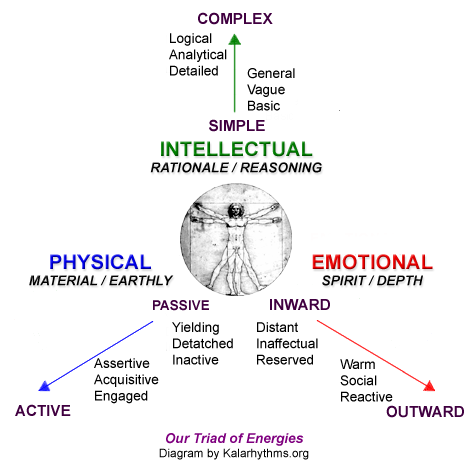
Triad of Energies – Physical, Emotional, Intellectual – Active-Passive, Inward-Outward, Simple-Complex
Physical, Emotional and Intellectual aspects are individuated and interconnected in living systems. The triad of energies replicates itself universally. In a person they are body, heart and mind. In a nation, they can be production, faith and education. In the global arena they can bring the Industrial Revolution, the Romantic Era and the Baroque Era of elaborate innovation, respectively. The triad continues.
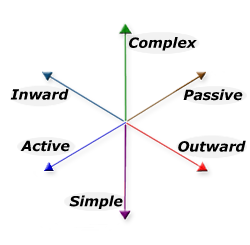
Polarities: Active-Passive, Inward-Outward, Simple-Complex

Trikonas – Physical, Emotional, Intellectual with Polarities
Whether we are more Physical, Emotional or Intellectual will change how we perceive things. If we are more Physical, we tend to be more action oriented and see things based on what one can do, and what one cannot. This gives us a win / loose polarity in our estimations. If, on the other other hand, we are more Emotional, we tend to judge things by how we feel and weigh them on their moral basis with a right / wrong polarity. And if we are more Intellectual, we tend to be more analytical than active or judgmental. This perspective has us view things on the basis of a true / false polarity. All three elements can be found to varying degrees in everyone’s style. It is the interplay of the triad.
Perceptions of Energy
Not only does our emphasis on these polarities change with different styles, but so does our perception of them. Below is a list of these they may be viewed from different perspectives:
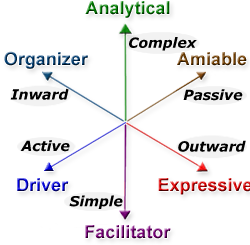
Personal Styles with Polarities
| POLE | PHY. | EMO. | INT. | |||
| WIN LOSE |
is | Succeed Fail |
or | Accept Reject |
or | Discover Disprove |
| RIGHT WRONG |
is | Effective Ineffective |
or | Just Unjust |
or | Fact Fiction |
| TRUE FALSE |
is | Tangible Intangible |
or | Sincere Insincere |
or | Correct Incorrect |
Polarities with Physical, Emotional & Intellectual points of view
Triaxial Energy
The great triad manifests in human form as with a body, heart and mind that give us our three Cycles; the Physical Cycle, Emotional Cycle and Intellectual Cycle. To symbolize our underlying energies in geometrical form, we could a use an upward triangle, or, the male trikona of Hindu mythology that symbolizes Shiva. To symbolize cominations of our underlying energies, we could use a downward triangle, or, the female trikona of Hindu mythology that symbolizes Shakti:

Physical, Emotional, Intellectual
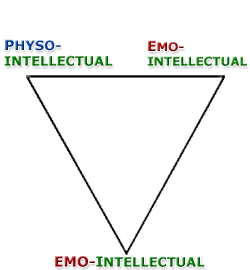
Physo-Emotional, Physo-Intellectual, Emo-Intellectual
Energy Model
Energies Combined produce styles in themselves as they blend elements from the triad of energies and form distinct patterns of behavior.
A simple geometrical model allows us to identify the elements of energy and how they may combine.

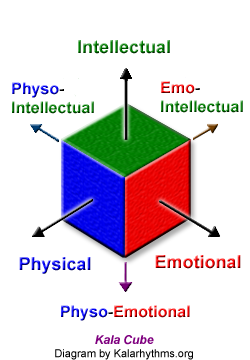
The Kala Cube is for the basis the model used to identify behavioral types Chapter 2. Personality Types.